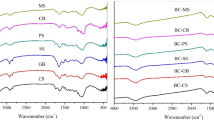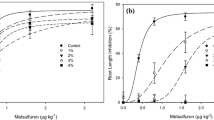Abstract
The pesticide behavior in soils can be easily affected by biochar addition. However, studies on the effects of raw feedstock and biochar are scarce. The objective of this study was to evaluate the effect of amending soils from three Midwestern U.S. states, with biochar produced from soybean residues, sugarcane bagasse, and wood chips (grape) as well as raw feedstock on the sorption–desorption and leaching potential of the pesticides aminocyclopyrachlor, metolachlor, and imidacloprid. Soil was amended at 10% (w w−1), and sorption–desorption studies were performed using the batch equilibration method. Following the determination of the sorption coefficient (Koc) values, the groundwater ubiquity score (GUS) indices for these pesticides were calculated. The highest pesticide sorption in all unamended soils followed the order imidacloprid (Kd = 0.79–1.66 L Kg−1) > metolachlor (Kd = 0.54–0.61 L Kg−1) > aminocyclopyrachlor (Kd = 0.12–0.23 L Kg−1). Biochar has the potential to decrease metolachlor and imidacloprid availability in soil through increased sorption, while the availability of aminocyclopyrachlor differed between the use of raw feedstock and biochar. Biochar derived from wood chips had the highest impact on pesticide behavior. We confirmed that aminocyclopyrachlor, metolachlor, and imidacloprid would leach easily in the three unamended soils, as illustrated by the GUS index.



Similar content being viewed by others
References
Rezende EL, Angelo LC, Santos SS, Mangrich AS (2011) Biocarvão (biochar) e sequestro de carbono. Rev Virtual Quím 3(5):426–433. https://doi.org/10.5935/1984-6835.20110046
Lehmann J, Rillig MC, Thies J, Masiello CA, Hockaday WC, Crowley D (2011) Biochar effects on soil biota - a review. Soil Biol Biochem 43(9):1812–1836. https://doi.org/10.1016/j.soilbio.2011.04.022
Mukome FND, Zhang X, Silva LCR, Six J, Parikh SJ (2013) Use of chemical and physical characteristics to investigate trends in biochar feedstocks. J Agric Food Chem 61(9):2196–2204. https://doi.org/10.1021/jf3049142
Zhao X, Ouyang W, Hao F, Lin C, Wang F, Han S, Geng X (2013) Properties comparison of biochars from corn straw with different pretreatment and sorption behaviour of atrazine. Bioresour Technol 147:338–344. https://doi.org/10.1016/j.biortech.2013.08.042
Ahmad M, Rajapaksha AU, Lim JE, Zhang M, Bolan N, Mohan D, Vithanage M, Lee SS, Ok YS (2014) Biochar as a sorbent for contaminant management in soil and water: A review. Chemosphere 99:19–33. https://doi.org/10.1016/j.chemosphere.2013.10.071
Freitas MAM, Passos ABRJ, Torres LG, Moraes HMF, Faustino LA, Rocha PRR, Silva AA (2014) Sorção do sulfentrazone em diferentes tipos de solo determinada por bioensaios. Planta Daninha 32(2):385–392. https://doi.org/10.1590/S0100-83582014000200016
Pesticide Properties Database—PPDB. 2020. Agriculture & Environment Research Unit (AERU). University of Hertfordshire. https://sitem.herts.ac.uk/aeru/ppdb/en/index.htm. Accessed 15 March 2020.
Guerra N, Oliveira RS Jr, Constantin J, Oliveira Neto AM, Gemelli A, Pereira DM Jr, Guerra A (2016) Persistence of biological activity and leaching potential of herbicides aminocyclopyrachlor and indaziflam in soils with different textures. Planta Daninha 34(2):345–356. https://doi.org/10.1590/S0100-83582016340200016
Francisco JG, Mendes KF, Pimpinato RF, Tornisielo VL, Dias ACR (2017) Aminocyclopyrachlor sorption-desorption and leaching from three Brazilian soils. J Environ Sci Health B 52(7):470–475. https://doi.org/10.1080/03601234.2017.1301758
Silva GS, Silva AFM, Mendes KF, Pimpinato RF, Tornisielo VL (2018) Influence of sugarcane straw on aminocyclopyrachlor leaching in a green-cane harvesting system. Water Air Soil Pollut 229(156):1–7. https://doi.org/10.1007/s11270-018-3818-x
Oliveira RS Jr, Alonso DG, Koskinen WC (2011) Sorption-desorption of aminocyclopyrachlor in selected Brazilian soils. J Agric Food Chem 59(8):4045–4050. https://doi.org/10.1021/jf104992w
Rittenhouse JL, Rice PJ, Spokas KA, Koskinen WC (2014) Assessing biochar’s ability to reduce bioavailability of aminocyclopyrachlor in soils. Environ Pollut 189:92–97. https://doi.org/10.1016/j.envpol.2014.02.022
Böger P, Matthes B, Schmalfuss J (2000) Towards the primary target of chloroacetamides - new findings pave the way. Pest Manag Sci 56(6):497–508. https://doi.org/10.1002/(SICI)1526-4998(200006)56:6%3c497:AID-PS169%3e3.0.CO;2-W
Weber JB, Mckinnon EJ, Swain LR (2003) Sorption and mobility of 14C-labeled imazaquin and metolachlor in four soils as influenced by soil properties. J Agric Food Chem 51(19):5752–5759. https://doi.org/10.1021/jf021210t
Jaikaew P, Malhat F, Boulange J, Watanabe H (2017) Aspect of the degradation and adsorption kinetics of atrazine and metolachlor in Andisol soil. Hell Plant Prot J 10(1):1–14. https://doi.org/10.1515/hppj-2017-0001
Trigo C, Spokas KA, Hall KE, Cox L, Koskinen WC (2016) Metolachlor sorption and degradation in soil amended with fresh and aged biochars. J Agric Food Chem 64(16):3141–3149. https://doi.org/10.1021/acs.jafc.6b00246
Tomizawa M, Casida LE (2000) Imidacloprid, thiacloprid and their imine derivatives up-regulate the alpha 4 beta 2 nicotinic acetylcholine receptor in M10 cells. Toxicol Appl Pharm 169(1):114–120. https://doi.org/10.1006/taap.2000.9057
Leiva JA, Nkedi-Kizza P, Morgan KT, Qureschi JA (2015) Imidacloprid sorption kinetics, equilibria, and degradation in sandy soils of Florida. J Agric Food Chem 62(20):4915–4921. https://doi.org/10.1021/acs.jafc.5b00532
Jin J, Mingjie K, Sun K, Pan Z, Wu F, Xing B (2016) Properties of biochar-amended soils and their sorption of imidacloprid, isoproturon and atrazine. Sci Total Environ 550:504–513. https://doi.org/10.1016/j.scitotenv.2016.01.117
Cabrera A, Cox L, Spokas K, Hermosin MC, Cornejo J, Koskinen WC (2014) Influence of biochar amendments on the sorption-desorption of aminocyclopyrachlor, bentazone and pyraclostrobin pesticides to an agricultural soil. Sci Total Environ 470:430–443. https://doi.org/10.1016/j.scitotenv.2013.09.080
Mendes KF, Hall KE, Spokas KA, Koskinen WC, Tornisielo VL (2017) Evaluating agricultural management effects on alachlor availability: tillage, green manure, and biochar. Agronomy 7(4):1–15. https://doi.org/10.3390/agronomy7040064
Organisation for Economic Co-Operation and Development – OECD, (2002) OECD guideline for the testing of chemicals 307, aerobic and anaerobic transformation in soil. OECD, Paris, p 44
Papiernik SK, Koskinen WC, Cox L, Rice PJ, Clay SA, Werdin-Pfisterer NR, Norber KA (2006) Sorption−desorption of imidacloprid and its metabolites in soil and vadose zone materials. J Agric Food Chem 54(21):8163–8170. https://doi.org/10.1021/jf061670c
Gustafson DI (1989) Groundwater Ubiquity Score: a simple method for assessing pesticide leachability. Environm Toxicol Chem 8(4):339–357. https://doi.org/10.1002/etc.5620080411
Cox L, Fernandes MC, Zsolnay A, Hermosin MC, Cornejo J (2004) Changes in dissolved organic carbon of soil amendments with aging: effect on pesticide adsorption behavior. J Agric Food Chem 52(18):5635–5642. https://doi.org/10.1021/jf0306035
Hall KE, Ray C, Ki SJ, Spokas KA, Koskinen WC (2015) Pesticide sorption and leaching potential on three Hawaiian soils. J Environ Manag 159:227–234. https://doi.org/10.1016/j.jenvman.2015.04.046
Mendes KF, Alonso FG, Mertens TB, Inoue MH, Oliveira MG, Tornisielo VL (2019) Aminocyclopyrachlor and mesotrione sorption–desorption in municipal sewage sludge-amended soil. Bragantia 78(1):131–140. https://doi.org/10.1590/1678-4499.2017441
Krutz LJ, Senseman SA, McInnes KJ, Hoffman DW, Tierney DP (2004) Adsorption and desorption of metolachlor and metolachlor metabolites in vegetated filter strip and cultivates soil. J Environ Qual 33(3):939–945. https://doi.org/10.2134/jeq2004.0939
Niandou MAS, Luster-Teasley S, Bandose RR, Novak JM, Rehrah D, Ahmedna M (2016) Adsorption isotherm parameters of atrazine and metolachlor with pecan Shell-based activated carbons. Inter J Agric Sci Technol 4:35–43. https://doi.org/10.12783/ijast.2016.0402.01
Kumar YB, Singh N, Singh SB (2013) Removal of atrazine, metribuzin, metolachlor and alachlor by granular carbon. Environ Anal Toxicol 3(7):196–200. https://doi.org/10.4172/2161-0525.1000196
Wei L, Huang Y, Li Y, Huang L, Mar NN, Huang Q, Liu Z (2017) Biochar characteristics produced from rice husks and their sorption properties for the acetanilide herbicide metolachlor. Environ Sci Pollut Res 24(5):45–52. https://doi.org/10.1007/s11356-016-8192-x
Kouakou YU, Dembele A, Ello AS, Brou YS, Yao BL, Troukourey A (2015) Study of adsorption of imidacloprid onto two different textures of soils. Inter J Biol Chem Sci 9(1):472–482. https://doi.org/10.4314/ijbcs.v9i1.40
Spokas KA, Koskinen WC, Baker JM, Reicosky DC (2009) Impacts of woodchip biochar additions on greenhouse gas production and sorption/degradation of two herbicides in a Minnesota soil. Chemosphere 77(4):74–581. https://doi.org/10.1016/j.chemosphere.2009.06.053
Khorram MS, Wang Y, Jin X, Fang H, Yu Y (2015) Reduced mobility of fomesafen through enhanced adsorption in biochar-amended soil. Environ Toxicol Chem 34(6):1258–1266. https://doi.org/10.1002/etc.2946
Beesley L, Jiménez EM, Eyles JLG, Harris E, Robinson B, Sizmur T (2011) A review of biochars’ potential role in the remediation, revegetation and restoration of contaminated soils. Environ Pollut 159(12):3269–3282. https://doi.org/10.1016/j.envpol.2011.07.023
Caracciolo AB, Giuliano G, Grenni P, Guzzella L, Pozzoni F, Bottoni P, Fava L, Crobe A, Orru M, Funari E (2005) Degradation and leaching of the herbicides metolachlor and diuron: a case study in an area of Northern Italy. Environ Pollut 134(3):525–534. https://doi.org/10.1016/j.envpol.2004.08.014
Dores EFGC, Souza L, Villa RD, Pinto AA (2013) Assessment of metolachlor and diuron leaching in a tropical soil using undisturbed soil columns under laboratory conditions. J Environ Sci Health B 48(2):114–121. https://doi.org/10.1080/03601234.2013.726900
Ghosh RK, Singh N (2012) Managing metolachlor and atrazine leaching losses using lignite fly ash. Ecotox Environ Safe 84:243–248. https://doi.org/10.1016/j.ecoenv.2012.07.015
Mandal A, Singh N, Purakayastha TJ (2017) Characterization of pesticide sorption behaviour of slow pyrolysis biochars as low cost adsorbent for atrazine and imidacloprid removal. Sci Total Environ 577:376–385. https://doi.org/10.1016/j.scitotenv.2016.10.204
Miranda GRB, Raetano CG, Silva E, Cerejeira MJ (2011) Environmental fate of neonicotinoids and classification of their potential risks to hypogean, epygean and surface water ecosystems in Brazil. Hum Ecol Risk Assess 17(4):981–995. https://doi.org/10.1080/10807039.2011.588159
Charalampous AC, Machera K, Miliadis GE, Koupparis MA (2015) The spatial and temporal distribution/variation of pesticide residues in Viotikos Kifissos basin before and after the application of a low input crop management system: A three-year study. Int J Environ Anal Chem 95(13):1263–1282. https://doi.org/10.1080/03067319.2015.1090564
Nyman AM, Hintermeister A, Schirmer K, Ashauer R (2013) The insecticide imidacloprid causes mortality of the freshwater amphipod Gammarus pulex by interfering with feeding behavior. PLoS One 8:1–13. https://doi.org/10.1371/journal.pone.0062472
Daam MA, Pereira ACS, Silva E, Caetano L, Cerejeira MJ (2013) Preliminary aquatic risk assessment of imidacloprid after application in an experimental rice plot. Ecotox Environ Safe 97:78–85. https://doi.org/10.1016/j.ecoenv.2013.07.011
Acknowledgements
The authors would like to thank the São Paulo Research Foundation (FAPESP) (2016/17683–1) and University of Minnesota for the financial support.
Author information
Authors and Affiliations
Corresponding author
Rights and permissions
About this article
Cite this article
Mendes, K.F., de Sousa, R.N., Goulart, M.O. et al. Role of raw feedstock and biochar amendments on sorption-desorption and leaching potential of three 3H- and 14C-labelled pesticides in soils. J Radioanal Nucl Chem 324, 1373–1386 (2020). https://doi.org/10.1007/s10967-020-07128-2
Received:
Published:
Issue Date:
DOI: https://doi.org/10.1007/s10967-020-07128-2




